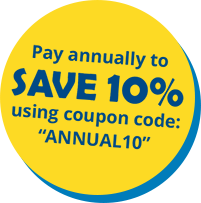The concept of a learning pod–a group of families who band together for regular learning and interaction–evolved more recently as a method of pooling resources and embedding limited socialization during pandemic shutdowns. Learning pods, also known as microschools, bring together several families of same- or mixed-aged students to share in an educational experience. Since their inception, they have evolved into an excellent solution for families using alternative modes of education, such as homeschooling or an accredited online school, who want to promote socialization, share instruction and materials, and join a network of support.
Benefits of Learning Pods
Let’s explore learning pods more thoroughly to see how they can bring the right balance between home-based education and group learning. Potential benefits of homeschool learning pods include:
- Opportunities to create friendships and share ideas through regular contact with like-minded families
- Options for group activities that individual families might miss, such as special-interest clubs, physical education, science labs, and public speaking
- Saving money by sharing expenses, supplies, and equipment, and through group field trip discounts
- Sharing teaching duties to give parents a much-needed break from lesson planning, provide more flexibility to work, and allow parents to teach the subjects in which they have the most knowledge and confidence
How Do Learning Pods Work? A Peek Inside Two Pods
Delphine pulled her two elementary-aged daughters out of school for a year to see if they might benefit from learning at their own pace through homeschooling. As they completed their first year of homeschooling, Delphine considered her options for the next school year. She learned of a local homeschool learning pod in her New York City borough, meeting together three mornings a week for shared learning time. The primary homeschool parent in each family took turns once a month directing that week’s activities.
In another part of the country, Lewis determined that his 9th-grade son needed a more individualized learning program, but Lewis worked full-time. He discovered Brightspire Virtual School, withdrew his son from public high school, and enrolled his son in the accredited, self-paced online virtual school. Locally, a learning pod was getting started that included some high school homeschoolers. His son joined the learning pod, made some new friends, and was able to work on homework with kids who were learning similar content.
For both families, joining a learning pod provided the adults with time and the kids with socialization. Delphine’s homeschool learning pod organized a book club, group science projects, and park days. Lewis’ son shared his love of birds with his pod by organizing a bird-watching field trip. Learning activities–like writing assignments, hands-on projects, and reading exercises– provided Delphine’s daughters with the opportunity to develop independent learning skills while Lewis benefitted from the collaborative learning opportunities that supported his understanding of the content he learned in the virtual school. As a result, both families benefited from the flexibility and individualized instruction of home instruction and from the combination of individual and collaborative learning activities in the learning pods.
Set Up Your Own Learning Pod
Has the idea of a learning pod intrigued you enough to try and create one of your own? You got this! Just as there is no one “right” way to educate your child, there is no limit on ways to set up a microschool. Here are the things we suggest to get started:
- Define the scope of your pod. If you are considering a full-time learning pod that meets daily and uses a planned curriculum, the homeschool laws in your state may stipulate whether you must organize as a private school or if you have the flexibility to share homeschooling responsibilities as a group.
- Choose a focus. Will your pod focus on all core subjects? Or will it focus on specific subjects, extracurricular activities, or supplemental learning? If you are considering a general learning pod, you’ll want to explore curricula that work well for groups.
- Find some families to join your pod! We recommend posting a query in your local homeschool Facebook group, on the Nextdoor app, or even at your library branch. Share your desired focus and scope and plan to fine-tune the details of your pod once you have some responses.
- Choose who will facilitate the pod. Will you hire a teacher or tutor to provide instruction and/or facilitate activities for your group? There are often teachers who are looking for part-time work or candidates in teaching programs who need hands-on experience prior to entering the workforce. Alternatively, parents in the learning pod can share the teaching responsibilities. This can be an ideal option because it requires no up-front costs and can take advantage of varied expertise that is already there.
- Consider the use of a professional learning pod organization that can provide additional support on the curricula you have chosen through coaching and opportunities to work and socialize with peers either online or locally. One such professionally-managed organization is Kaipod:
KaiPod Learning is a comprehensive support network providing coaching assistance and curated opportunities for socialization with peers online or locally. You can ensure a well-rounded, engaging educational experience tailored to your child’s needs. Start your journey with a KaiPod today!
An important thing to note is that for any learning pod, adaptability is key. You may discover that your original scope was too narrow or too broad. Your chosen curriculum may need tweaking or supplements. The focus may shift with changing curiosities of the individual students in the pod. Allowing your learning pod to develop and mature as the students and their families’ needs shift will help everyone.
Using Time4Learning in Learning Pods
Since learning pods don’t require a specific curriculum, the choice is up to the parents. However, to accommodate your learning pod’s evolving needs, you should choose a curriculum that is flexible and easily accessible.
Time4Learning offers an award-winning, online curriculum for PreK-12th grade that allows students to work independently and at their own pace. Each student receives an individual log in, and an automated system grades and records progress. Time4Learning can be accessed 24/7 from any location with an internet connection, making it a convenient, flexible choice for learning pods.
Families can register up to 10 students in one account (up to five in PreK-8 and up to five in high school), and each family account includes one parent login. A designated parent or pod instructor can easily manage student accounts through the use of a unique password. That person will have access to each child’s records in order to keep track of work completed, time on task, grades, and more. Alternatively, each parent in a learning pod can sign up for Time4Learning with an individual account and either provide access to the learning pod leader, or easily share their child’s records by exporting as a PDF or an Excel spreadsheet.
When it comes to learning pods, there is no right and wrong. Each one is as unique as its families. Learning pods can be an outstanding solution for families whose goals include flexible scheduling, individual and collaborative learning, and socialization, and for parents who would appreciate shared instructional time and materials and a network of support. Start your own learning pod or find an existing one to reap all of the benefits of this unique educational option!







